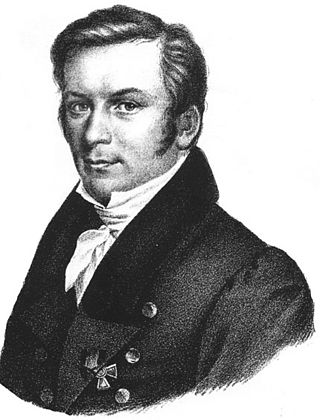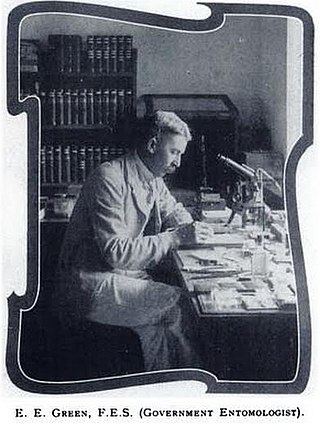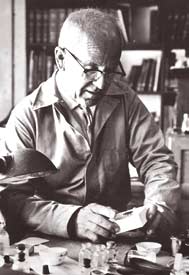Related Research Articles

Entomology is the scientific study of insects, a branch of zoology. In the past the term "insect" was less specific, and historically the definition of entomology would also include the study of animals in other arthropod groups, such as arachnids, myriapods, and crustaceans. This wider meaning may still be encountered in informal use.

Johann Friedrich Gustav von Eschscholtz was a Baltic German physician, naturalist, and entomologist. He was one of the earliest scientific explorers of the Pacific region, making significant collections of flora and fauna in Alaska, California, and Hawaii.

Francis Walker was an English entomologist. He was born in Southgate, London, on 31 July 1809 and died at Wanstead, England on 5 October 1874. He was one of the most prolific authors in entomology, and stirred controversy during his later life as his publications resulted in a huge number of junior synonyms. However, his assiduous work on the collections of the British Museum had great significance.

Charles E. Woodworth (1897–1966) served as a major in the United States Army during World War II and as an entomologist for the United States Department of Agriculture Agricultural Research Service.
Philip Hunter Timberlake (1883-1981) was one of the most prolific American entomologists of the 20th century. He was born on June 5, 1883 in Bethel, Maine, and died in 1981 in Riverside, California, where he had served as an Associate Entomologist in the Department of Entomology of the University of California, Riverside.

Vernon Lyman Kellogg was an American entomologist, evolutionary biologist, and science administrator. He established the Department of Zoology at Stanford University in 1894, and served as the first permanent secretary of the National Research Council in Washington, DC.

Margaret Elizabeth Fountaine, was a Victorian lepidopterist, natural history illustrator, diarist, and traveller who published in The Entomologist's Record and Journal of Variation. She is also known for her personal diaries, which were edited into two volumes by W.F. Cater for the popular market and published posthumously.

William Dandridge Peck was an American naturalist, the first native-born entomologist and a pioneer in the field of economic entomology. In 1806 he became the first professor of natural history at Harvard, a position he held until his death in 1822.

Edward Ernest Green was an Ceylon-born English mycologist and entomologist who specialised in the scale-insects, Coccidae. An accomplished artist, and lithographer, he illustrated the five volume Coccidae of Ceylon.
Edward Oliver Essig was an American entomologist who specialized in the Hemiptera.
Elwood Curtin Zimmerman was an American entomologist best known for his two multivolume series: Insects of Hawaii published by the University of Hawaiʻi Press and Australian Weevils published by Australia's CSIRO.

Thomas Blackburn was an English-born Australian priest and entomologist who specialized in the study of beetles.
Gordon Floyd Ferris was an American entomologist who served as professor of biology at Stanford University from 1912 to 1958 and earned a reputation for his teaching. He founded and edited the journal Microentomology, preferring to work on insects that could only be examined on microscopic slides. He was a specialist on the systematics of the Coccoidea.

The Bohart Museum of Entomology was founded in 1946 on the campus of the University of California, Davis. The museum is currently the seventh largest insect collection in North America with more than seven million specimens of terrestrial and freshwater arthropods. At least 90% of these holdings are insects. The collection is worldwide in scope with the Western Hemisphere, Indonesia, and Australasia particularly well represented.
Richard Mitchell Bohart was an American entomologist, university professor, and a member of the University of California, Davis Department of Entomology for more than 50 years. He taught courses in general entomology, insect systematics, and summer field courses in insect identification. From 1963 to 1967 he served as chair of the Department of Entomology for the University of California at Davis.

Charles F. Harbison (1904–1989) was an American entomologist and the curator of entomology at the San Diego Natural History Museum from 1942 to 1969. An avid field naturalist and researcher, Harbison influenced a generation of San Diego-born scientists in many fields of natural history through the Junior Naturalist program at the museum.
Edwin Cooper Van Dyke was an American physician and entomologist. A leading authority on beetles (Coleoptera) of the Pacific Coast of North America, he was also an expert on insect pests of forests and forest products. He became a professor of entomology at the University of California, Berkeley and worked on the curatorial staff at the California Academy of Sciences for almost fifty years.
Ralph H. Hopping was an American-born Canadian entomologist who specialized in Coleoptera.

The Lincoln University Entomology Research Collection is a collection of approximately 500,000 insect, spider, and other arthropod specimens housed in Lincoln University, New Zealand. One of New Zealand's largest insect research collections, it is the only one based in a university.

The UPLB Museum of Natural History is a natural science and natural history museum within the University of the Philippines Los Baños (UPLB) campus. It serves as a center for documentation, research, and information of flora and fauna of the Philippines. The museum is one of the research and extension units of the UPLB and its role parallels that of a library for written records.
References
- ↑ "Essig Museum of Entomology". Essig Museum of Entomology. Retrieved 14 October 2014.
- ↑ Miller, S.E. (1991), "Entomological Collections in the United States and Canada", American Entomologist, 37 (2): 77–84, doi:10.1093/ae/37.2.77, archived from the original on 29 May 2015, retrieved 29 May 2015
- ↑ "Essig Museum at Entomology Today". Entomology Today. Retrieved 14 October 2014.
- ↑ Lee, J Hannah (29 May 2013). "Researchers enlist public to sort more than 1 million bugs online". The Daily Californian. Retrieved 14 October 2014.